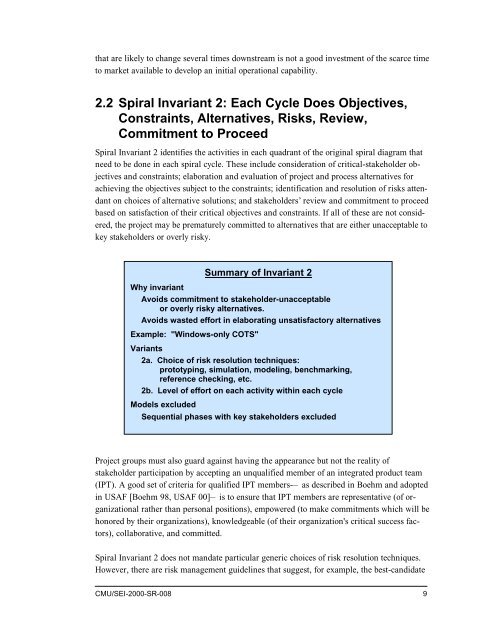00sr008
00sr008
00sr008
You also want an ePaper? Increase the reach of your titles
YUMPU automatically turns print PDFs into web optimized ePapers that Google loves.
that are likely to change several times downstream is not a good investment of the scarce time<br />
to market available to develop an initial operational capability.<br />
2.2 Spiral Invariant 2: Each Cycle Does Objectives,<br />
Constraints, Alternatives, Risks, Review,<br />
Commitment to Proceed<br />
Spiral Invariant 2 identifies the activities in each quadrant of the original spiral diagram that<br />
need to be done in each spiral cycle. These include consideration of critical-stakeholder objectives<br />
and constraints; elaboration and evaluation of project and process alternatives for<br />
achieving the objectives subject to the constraints; identification and resolution of risks attendant<br />
on choices of alternative solutions; and stakeholders’review and commitment to proceed<br />
based on satisfaction of their critical objectives and constraints. If all of these are not considered,<br />
the project may be prematurely committed to alternatives that are either unacceptable to<br />
key stakeholders or overly risky.<br />
Why invariant<br />
Summary of Invariant 2<br />
Avoids commitment to stakeholder-unacceptable<br />
or overly risky alternatives.<br />
Avoids wasted effort in elaborating unsatisfactory alternatives<br />
Example: "Windows-only COTS"<br />
Variants<br />
2a. Choice of risk resolution techniques:<br />
prototyping, simulation, modeling, benchmarking,<br />
reference checking, etc.<br />
2b. Level of effort on each activity within each cycle<br />
Models excluded<br />
Sequential phases with key stakeholders excluded<br />
Project groups must also guard against having the appearance but not the reality of<br />
stakeholder participation by accepting an unqualified member of an integrated product team<br />
(IPT). A good set of criteria for qualified IPT members-— as described in Boehm and adopted<br />
in USAF [Boehm 98, USAF 00]— is to ensure that IPT members are representative (of organizational<br />
rather than personal positions), empowered (to make commitments which will be<br />
honored by their organizations), knowledgeable (of their organization's critical success factors),<br />
collaborative, and committed.<br />
Spiral Invariant 2 does not mandate particular generic choices of risk resolution techniques.<br />
However, there are risk management guidelines that suggest, for example, the best-candidate<br />
CMU/SEI-2000-SR-008 9














